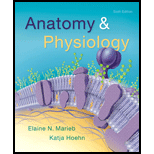
Concept explainers
Which of the following forms of energy is the stimulus for vision? (a) chemical, (b) electrical, (c) mechanical, (d) radiant.
To determine:
The stimulus for vision from following forms of energy:
Chemical
Electrical
Mechanical
Radiant
Answer to Problem 1MC
Solution:
(d) Radiant: Vision is found operable only in the presence of light and light is classified as a form of radiant energy. The radiant energy can be defined as the energy of the gravitational radiation and electromagnetic radiation.
Explanation of Solution
Explanation for correct answer:
The radiant energy is usually used in the lighting, heating, solar energy, and radiometry. The radiant energy travels in the form of waves. The lengths of these waves are different and the spectrum of these waves is known as the electromagnetic spectrum. The radiant energy includes infrared waves, ultraviolet waves, X-rays, visible light, and radio waves. The light energy stimulates the eyes and plays a significant role in vision. Thus option (d) is the correct option.
Explanation for incorrect answer:
Option (a) is given as chemical energy is the stimulus for vision. This is an incorrect option as chemical energy that is released during a chemical reaction, is used to produce other form of energy like heat or mechanical energy. For example: Chemical energy of food is burn to produce mechanical energy or heat.
Option (b) is given as electrical energy is the stimulus for the vision. This is an incorrect option as electrical energy results from the flow of electric charge and mainly regulates the nervous system of an organism.
Option (c) is given as mechanical energy is the stimulus for vision. This is an incorrect option as mechanical energy is involved in movement processes such as lifting heavy object or running. Here, muscle contraction transforms the chemical energy into mechanical energy.
Thus it is concluded that radiant energy that includes infrared waves, ultraviolet waves, X-rays, visible light, and radio waves, plays a vital role as stimulus for the vision.
Want to see more full solutions like this?
Chapter 2 Solutions
Anatomy & Physiology (6th Edition)
- What are Clathrin coated vesicles and what is their function?arrow_forwardHow is a protein destined for the Endoplasmic Reticulum (ER), imported into the ER? Be concise.arrow_forwardFind out about the organisations and the movements aimed at the conservation of our natural resources. Eg Chipko movement and Greenpeace. Make a project report on such an organisation.arrow_forward
- What are biofertilizers and mention the significancearrow_forwardPCBs and River Otters: Otters in Washington State’s Green-Duwamish River have high levels of polychlorinated biphenyls (PCBs) in their livers. PCBs can bind to the estrogen receptors in animals and disrupt the endocrine system of these otters. The PCBs seem to increase the estrogen to androgen ratio, skewing the ratio toward too much estrogen. How would increased estrogen affect the river otter population? Based on your reading of the materials in this unit, what factors can affect fertility in humans? Explain how each of the factors affecting human fertility that you described can disrupt the human endocrine system to affect reproduction.arrow_forwardOther than oil and alcohol, are there other liquids you could compare to water (that are liquid at room temperature)? How is water unique compared to these other liquids? What follow-up experiment would you like to do, and how would you relate it to your life?arrow_forward
- Selection of Traits What adaptations do scavengers have for locating and feeding on prey? What adaptations do predators have for capturing and consuming prey?arrow_forwardCompetition Between Species What natural processes limit populations from growing too large? What are some resources organisms can compete over in their natural habitat?arrow_forwardSpecies Interactions Explain how predators, prey and scavengers interact. Explain whether predators and scavengers are necessary or beneficial for an ecosystem.arrow_forward
- magine that you are conducting research on fruit type and seed dispersal. You submitted a paper to a peer-reviewed journal that addresses the factors that impact fruit type and seed dispersal mechanisms in plants of Central America. The editor of the journal communicates that your paper may be published if you make ‘minor revisions’ to the document. Describe two characteristics that you would expect in seeds that are dispersed by the wind. Contrast this with what you would expect for seeds that are gathered, buried or eaten by animals, and explain why they are different. (Editor’s note: Providing this information in your discussion will help readers to consider the significance of the research).arrow_forwardWhat is the difference between Uniporters, Symporters and Antiporters? Which of these are examples of active transport?arrow_forwardWhat are coupled transporters?arrow_forward
 Principles Of Radiographic Imaging: An Art And A ...Health & NutritionISBN:9781337711067Author:Richard R. Carlton, Arlene M. Adler, Vesna BalacPublisher:Cengage Learning
Principles Of Radiographic Imaging: An Art And A ...Health & NutritionISBN:9781337711067Author:Richard R. Carlton, Arlene M. Adler, Vesna BalacPublisher:Cengage Learning
 Biology (MindTap Course List)BiologyISBN:9781337392938Author:Eldra Solomon, Charles Martin, Diana W. Martin, Linda R. BergPublisher:Cengage Learning
Biology (MindTap Course List)BiologyISBN:9781337392938Author:Eldra Solomon, Charles Martin, Diana W. Martin, Linda R. BergPublisher:Cengage Learning Human Physiology: From Cells to Systems (MindTap ...BiologyISBN:9781285866932Author:Lauralee SherwoodPublisher:Cengage Learning
Human Physiology: From Cells to Systems (MindTap ...BiologyISBN:9781285866932Author:Lauralee SherwoodPublisher:Cengage Learning Concepts of BiologyBiologyISBN:9781938168116Author:Samantha Fowler, Rebecca Roush, James WisePublisher:OpenStax College
Concepts of BiologyBiologyISBN:9781938168116Author:Samantha Fowler, Rebecca Roush, James WisePublisher:OpenStax College Biology 2eBiologyISBN:9781947172517Author:Matthew Douglas, Jung Choi, Mary Ann ClarkPublisher:OpenStax
Biology 2eBiologyISBN:9781947172517Author:Matthew Douglas, Jung Choi, Mary Ann ClarkPublisher:OpenStax





